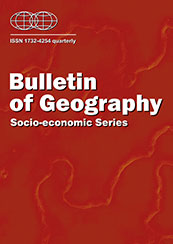Is there a relationship between the use of motorcycles and the level of development of countries?
DOI:
https://doi.org/10.2478/bog-2020-0031Keywords
motorcycles, human development index, panel data, developed countries, developing countriesAbstract
Our paper aims to analyse the hypothesis that locations with a higher Human Development Index (HDI) present lower rates of motorcycle use. For this we use an econometric model for 117 countries on five continents for the years 2013, 2015 and 2018. We assume that when a country reaches a higher level of development, its population is more likely to experience improvements in the quality of life, which also affects the quality of individual transportation, public transport and roads. Increases in income discourage the use of motorcycles, mainly due to their low safety and comfort features. Our results indicate that rates of motorcycle use in countries increase as HDI rises, before reaching a maximum point and then declining. Therefore, this evidence suggests that a certain degree of development discourages the use of this means of transport in favour of others.
References
/Andi (2017). Cámara de la Industria Automotriz de la Asociación Nacional de Empresarios de Colombia, 2017. Available at: http://www.andi.com.co/Uploads/LasMotocicletasEnColombia.pdf.
/Blackman, R. A., & Haworth, N. L. (2010). A qualitative exploration of the attitudes and experiences of moped and scooter riders. In Transportation Research Board 89th Annual Meeting Compendium of Papers (pp. 1-16). Transportation Research Board/National Academy of Sciences.
/Da Silva, E. R., Cardoso, B. C., & de Sequeira Santos, M. P. (2011). O AUMENTO DA TAXA DE MOTORIZAÇÃO DE MOTOCICLETAS NO BRASIL. Revista Brasileira de Administração Científica, 2(2).
/Dargay, J., Gately, D., & Sommer, M. (2007). Vehicle ownership and income growth, worldwide: 1960-2030. The energy journal, 28(4).
/FCAI (2016). FCAI Motorcycle Group: National Sales Report. Federal Chambers of Automotive Industries, Canberra, Australia. Available at:https://www.fcai.com.au/library/publication/fcai_ar_2016_web.pdf.
/
/Hagen, J. X., Pardo, C., & Valente, J. B. (2016). Motivations for motorcycle use for Urban travel in Latin America: A qualitative study. Transport Policy, 49, 93-104.
/Haworth, N. (2012). Powered two wheelers in a changing world—Challenges and opportunities. Accident Analysis & Prevention, 44(1), 12-18.
/HUMAN DEVELOPMENT REPORTS (2019). Available at:http://hdr.undp.org/en/data.
/Kopits, E., & Cropper, M. (2008). Why have traffic fatalities declined in industrialised countries?: Implications for pedestrians and vehicle occupants. Journal of Transport Economics and Policy (JTEP), 42(1), 129-154.
/Morris, C. C. (2009). Motorcycle trends in the United States (No. SR-014). United States. Bureau of Transportation Statistics. Available at: https://www.bts.gov/sites/bts.dot.gov/files/legacy/publications/special_reports_and_issue_briefs/special_report/2009_05_14/pdf/entire.pdf.
/Nagai, Y., Fukuda, A., Okada, Y., & Hashino, Y. (2003). Two-wheeled vehicle ownership trends and issues in the Asian region. Journal of the Eastern Asia Society for Transportation Studies, 5, 135-146.
/Nishitateno, S., & Burke, P. J. (2014). The motorcycle Kuznets curve. Journal of Transport Geography, 36, 116-123.
/Pongthanaisawan, J., & Sorapipatana, C. (2010). Relationship between level of economic development and motorcycle and car ownerships and their impacts on fuel consumption and greenhouse gas emission in
Thailand. Renewable and Sustainable Energy Reviews, 14(9), 2966-2975.
/Rogers, N. (2008, June). Trends in motorcycles fleet worldwide. In Presentation to Joint OECD/ITF Transport Research Committee Workshop on Motorcycling Safety.
/Vasconcellos, E. A. (2008). O custo social da motocicleta no Brasil. Revista dos Transportes Públicos–ANTP, ano, 30, 31.
/Vasconcellos, E. A. D. (2013). Road safety impacts of the motorcycle in Brazil. International journal of injury control and safety promotion, 20(2), 144-151.
/World Health Organization. (2013). Global status report on road safety 2013. World Health Organization.
/World Health Organization. (2015). Global status report on road safety 2015. World Health Organization.
/World Health Organization. (2018). Global status report on road safety 2018. World Health Organization.
Downloads
Published
How to Cite
Issue
Section
License
Copyright (c) 2020 Bulletin of Geography. Socio-economic Series

This work is licensed under a Creative Commons Attribution-NonCommercial-NoDerivatives 4.0 International License.
Title, logo and layout of journal Bulletin of Geography. Socio-economic Series are reserved trademarks of Bulletin of Geography. Socio-economic Series.Stats
Number of views and downloads: 1900
Number of citations: 2



